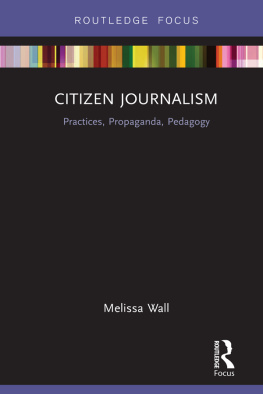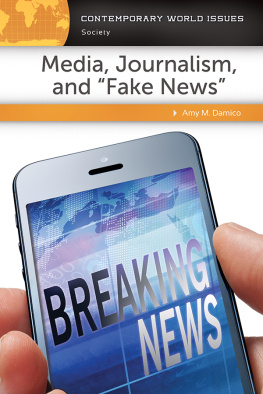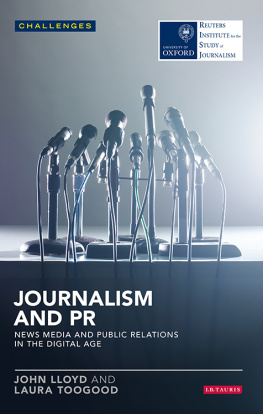

In clear prose and with excellent attention to detail, Martin Hirst makes a significant contribution to debates about the future of journalism in a digital world. In doing so, News 2.0 provides a powerful reply to those whose utopian dreams cloud their thinking about the political, social, economic and cultural implications of digital convergence.
Vincent Mosco, Canada Research Chair, Queens University
Martin Hirsts News 2.0 offers a scholarly, insightful and authoritative account of the radical changes in journalism in an age of globalisation and mobile news... essential reading for students, journalists and every one interested in the future of news and journalism.
Bob Franklin, Professor of Journalism Studies, Cardiff University
Martin Hirst tackles the urgent questions that surround journalism from a pragmatic yet radical perspective. News 2.0 is sharp, insightful, and intelligent, and should be required reading for everyone involved in journalism, as well as citizens who value its role in democracy.
Janet Wasko, Knight Chair in Communication Research, University of Oregon
Martin Hirsts important text provides much needed grounded insight and foresight (rather than angst and speculation) into journalisms present condition and uncertain future. You might not always agree with his analysis but the scope of his exploration of journalism in the era of Web 2.0 is impressive. Anyone interested in where journalism finds itself now, and where it may be headed any time soon, should start by reading this book.
Michael Bromley, Professor of Journalism, University of Queensland
Martin Hirst
News 2.0
Can journalism survive the Internet?
First published 2011 by Allen & Unwin
Published 2020 by Routledge
2 Park Square, Milton Park, Abingdon, Oxon OX14 4RN
605 Third Avenue, New York, NY 10017
Routledge is an imprint of the Taylor & Francis Group, an informa business
Copyright Martin Hirst 2011
Tom Tomorrow's The Future on p. i reproduced with the kind permission of the artist.
All rights reserved. No part of this book may be reprinted or reproduced or utilised in any form or by any electronic, mechanical, or other means, now known or hereafter invented, including photocopying and recording, or in any information storage or retrieval system, without permission in writing from the publishers.
Notice:
Product or corporate names may be trademarks or registered trademarks, and are used only for identification and explanation without intent to infringe.
Cataloguing-in-Publication details are available from the National Library of Australia
www.trove.nla.gov.au
Index by Puddingburn Publishing Services
Set in 11.5/14 pt Bembo by Post Pre-press Group, Australia
ISBN-13: 9781742370576 (pbk)
For my family, who instilled the values I hold dear, and to Tiffany White, the mother of all creatures. She still loves me, despite the many lost weekends.
All that is established melts into air; all that is holy is profaned, and man is at last compelled to face with sober senses his real conditions of life and his relations with his kind.
The Communist Manifesto
The bulk of this book was written over a period of two years between the middle of 2008 and April 2010. In that time the worlds media systems were caught up in a massive vortex of uncertainty and change. News 2.0 captures the flavour of that period and sets it against an historical background. In short: Where did the news medias crisis of confidence and lack of commercial certainty come from and what are their likely impacts? A starting point for this book is the sense that the news media have
A starting point for this book is the sense that the news media have changed more in the last decade than they did in the preceding 30 years. A corollary is that they are likely to change again over the next 10 years. Therefore, it is impossible for a text like this to be completely up-to-date. Important and relevant things may have happened in the time between the manuscript going into production and today. Obviously, that will be seen as a gap in the record, a hole in the text. My excuse: there is no crystal ball.
However, I have tried to include enough data and analysis to (it is hoped) make News 2.0 useful to a general readership and relevant to students of journalism and to the news media industry. In these pages I have laid out some thoughts about why the public no longer seems to trust most mainstream journalism and why the production of the news commodity is no longer providing rivers of gold in advertising revenues. I have surveyed and discussed what some may call citizen journalism, which I prefer to define as user-generated news- like content (UGNC). Where did UGNC come from and can it save the media? I have not tried to give a definitive response to this or other questions; nor to suggest a sure- fire set of solutions. Predictions have a selfish habit of being wrong. Instead, the last two chapters attempt to signal some possible futuresthose that seem most plausible given that the world faces what the American media scholar Robert McChesney calls a critical juncture in the history and development of global media.
If that does not satisfy you, I am sorry. Howeveras Marx and Engels wrote in The Communist Manifestoit is our choices that will determine the future. As the power of social networking shows us, we can exert pressure on the global mediasphere, but we must begin from the reality of where we are today. Our starting point must be to face with sober senses the real conditions in which we find ourselves. We first have to make sense of, and come to terms with, the present by understanding that the turbulence of today is created by the rapidly approaching and inevitable media future disrupting the certainties of our media past. Armed with this crucial knowledgefacing our actual conditions with a clear headwe have a chance to make real a vision shared by many: a democratic media operating on the principles of public service and the public interest. Whether that is a future consisting of citizen journalism, a mix of big and small media in public and private ownership, or a situation very much like today, in which an unrepresentative group of powerful private corporations control most of what we can see, say, hear and read, only time will tell. All I am certain of is that our actions can now make a difference to this future. That News 2.0 took almost two years to complete was both a blessing and a curse. It was a curse because I had nightmares about looming deadlines, all of which passed in quick succession and made the nightmares worse. It was a blessing because without the many delays and interruptions I would not have caught the Twitter wave and the iPad phenomenon, nor would I have seen the Witches of Facebook, the nasty trolls who infect social media sites with racist, sexist or homophobic ranting and who canif not challengedmake our online experiences thoroughly unpleasant. All of these moments were crucial to the themes of









